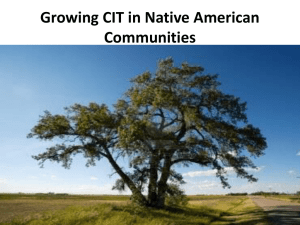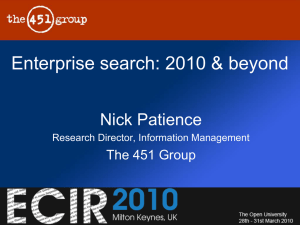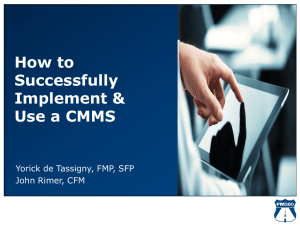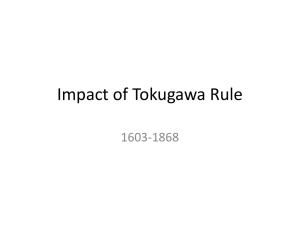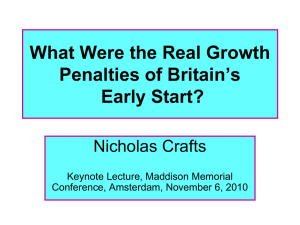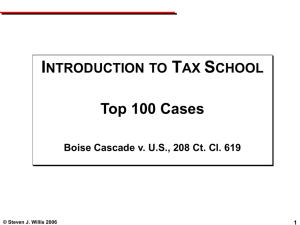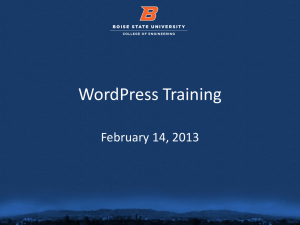What are Your Market Numbers?
advertisement
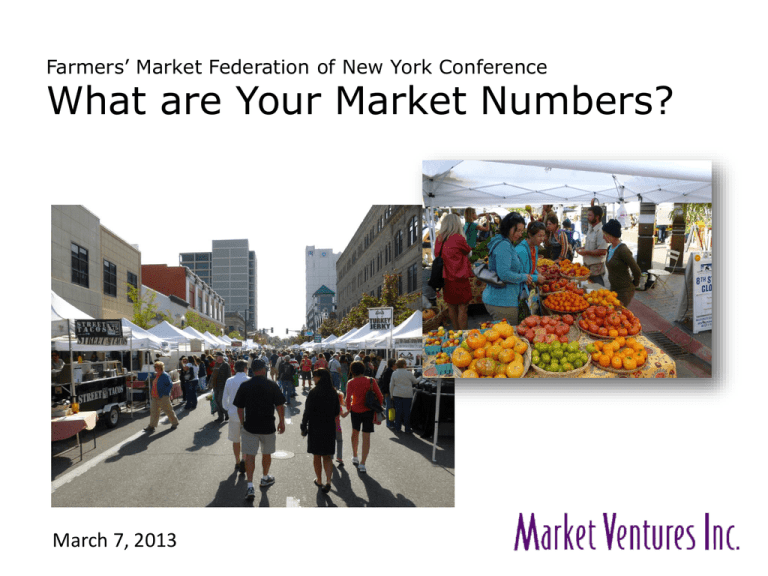
Farmers’ Market Federation of New York Conference What are Your Market Numbers? March 7, 2013 Presentation Topics 1. About Market Ventures, Inc. 2. Customer analysis 3. Vendor analysis 4. Market records Market Ventures, Inc. Consulting / Development / Operations • National consultants on public markets and food-based economic development projects • Lead Author, Public Markets and Community Revitalization • Conduct public market feasibility studies and research throughout the United States By Ward Market, Ottawa Rochester Public Market Grand Rapids Downtown Market Market Ventures, Inc. Recent Projects • Grand Rapids Downtown Market (opening July 2013) • Charlottesville City Market District Plan • Rochester Public Market Renovation & Expansion Plan • Boise Public Market Feasibility Study • Grand Traverse Regional Market/Food Hub Feasibility Study • Fort Collins Community Marketplace Feasibility Study • Salt Lake City Public Market District Plan • Broome County Regional Farmers’ Market Feasibility Study • NYC Wholesale Farmers’ Market Feasibility Study and Development Plan • SchoolFood Plus Initiative (NYC) Program Evaluation • Milwaukee Public Market Feasibility Study & Concept Plan • Tioga County Cooperative Market & Distribution Study • Reading Terminal Market Merchandising Plan • Developer/Operator: Bronx Sunday Market, Portland Public Market • President, Farm to Market, Inc. • Co-owner, Maine’s Pantry Questions to Answer about Customers • Who’s coming to the market now? • Who is not coming that you would like to attract? – Higher spending consumers – Low income residents – Children • • • • Why are customers coming to the market? Where else do they shop for food? How did they hear about the Market? What are their visit characteristics? – How long do they stay – What do they buy – How much do they spend • Customer concerns or issues Customer Research Methods • Qualitative methods – Key informant interviews – Focus groups • Quantitative methods – – – – Customer counts Dot surveys Intercept surveys Web-based surveys (e.g., Survey Monkey, Zoomerang) • Trade area demographic data – Trade areas determined by intercept surveys – Compare current customers with residents within the trade areas Qualitative Methods • Key informant interviews – Select respondents – Prepare questions but allow flexibility to explore topics as they emerge – Identify major issues • Focus Groups – Efficient means to interview a group of market customers – Invite representative range of customers (gender, age, location of residence, income, household composition) – Guided conversation – prepare questions – Record or have person taking notes – Good method for testing ideas Rapid Market Assessment Boise Capital City Public Market • Saturday open-air farmers’ market in Downtown Boise • ~160 vendors (31% ag, 23% prepared food, 45% arts) • Rapid Market Assessment methods – 14 volunteers gathered attendance at 15 market entrances for 10 minutes per hour over 4 hour period – Dot survey set up at 2 locations with 4 flip charts (10 volunteers) – Each respondent given 4 dots • Dot survey questions – What is your primary reason for coming to the Market today? – How often have you shopped at the Market this year? – About how much have you or will you spend at the Market today? – How much have you or will you spend at other Downtown businesses today? Rapid Market Assessment Boise Capital City Public Market 2011 2009 Agriculture Products 39% 38% Music 2% 2% • Estimated 17,443 visitors • 45% of visitors come for the atmosphere, 39% for the ag products Arts 5% 8% Atmosphere 45% 45% How much spent given in 6 categories; can’t capture very high sales which would skew average upward Prepared Foods 8% 4% Children’s Programs 1% 3% • • • Can approximate average customer sale by multiplying midpoint of ranges by number of respondents, and dividing resulting total sales by total number of respondents (~$19) Can approximate total market daily sales by dividing total attendees by estimated group size (2) and multiplying by average sale (17,443 ÷ 2 x $19=$168,000) How Much Spend at Market Today? Boise Capital City Public Market 700 600 500 400 300 200 100 0 0 $1-20 21-30 31-40 41-50 50+ Customer Intercept Survey • Survey design – Exit survey – what did you do today at the market, not what you “usually” do – Clear questions without ambiguity – Keep short but complete – Test survey instrument • Sample size – More the better, allows to dig deep into data – 100 minimum, 300 preferred – Conduct over multiple days and repeat annually • Training – – – – – – • Speak to customers as they leave the market Avoid selection bias Knowledgeable and cheerful interviewers One person takes survey Don’t change questions Record interviewers’ observations Manager review all surveys soon after completed Customer Intercept Survey: Demographic Profile Gender Age 90 80 Male 31% 70 60 50 Female 69% 40 30 20 10 0 Under 25 25-39 40-54 55-70 Race Over 70 Hispanic 8% Black 0% • Conducted two Saturdays • 262 Surveys Completed Other 6% White 86% Customer Intercept Survey: Demographic Profile Zip Codes (most prevalent) Zip Codes Out of State 3% Outside Boise 13% 83709 83646 83716 83704 83703 83714 Boise (83702-716) 84% 83705 83712 83706 83702 0.0% 5.0% 10.0% 15.0% 20.0% Q23. What is your home zip code? (N=253) 25.0% 30.0% Customer Intercept Survey: Demographic Profile Household Income 2010 25.0% Household Income 2010 20.0% 15.0% Upper income >$75k 42% 10.0% 5.0% 0.0% Under $15,000 • $15,000 to $25,001 to $50,001 to $75,001 to $100,001 to Over $25,000 $50,000 $75,000 $100,000 $150,000 $150,000 Boise median household income 2009 = $50,633 (quickfacts.census.gov) Q26. What range includes your total household income, before taxes, for 2010? (N=215) Lower inocme <=$25k 12% Middle income $25-75k 46% Customer Intercept Survey: Visit Characteristics Travel Time to Market Travel Mode to the Market 56.3% Bus 2% Walk 14% Bicycle 12% 21.1% 19.5% Car 72% 2.7% Less than 5 min 5 - 15 min 16 - 30 min 0.4% 31 - 60 min More than 60 min Groupsize Q1. To get to the Market today, did you walk, bicycle, drive in a car, or take a bus? (N=254) Q2. How long did you travel to get to the Market today? (N=261) Q3. Including yourself, how many people came with you to the Market? (N=258) Average 2.1 Min 1 Max 12 Mode 2 48% Mode 1 or 2 75% Customer Intercept Survey : Visit Characteristics Last Visit to the Market More than a month ago 20% This Month 73% Last Saturday 38% Within the past month 35% First time here 7% Q4. Before today, when was the last time you came to the Market? (N=260) Customer Intercept Survey: Visit Characteristics Number of Vendors Shoppers Bought From 100 90 80 Shoppers 70 60 50 40 30 20 10 0 0 1-2 3-4 5-6 7 or more Number of Vendors Range: 0-12 Mean: 3.5 Q5. Counting everywhere you made a purchase today, how many different vendors did you buy from? (N=245) Customer Intercept Survey: Purchasing What Purchased Food to take home 85% Food to eat in market 55% Nonfood/crafts 21% Bought nothing 5% Bought all three 11% Both foods, no crafts 37% Food to take home only 32% 0% 10% 20% 30% 40% 50% 60% 70% Q6. Did you buy any food today that you ate while in the Market? (N=247) Q8. Did you buy food to take home or take away from the Market today? (N=251) Q10. Did you buy any crafts or nonfood items at the Market today? (N=248) 80% 90% Customer Intercept Survey: Purchasing Purchases Food to take home Eat on premises Crafts/nonfoods Total Average (among those who spent) $29.67 $9.53 $30.88 $37.15 Average (all customers) $23.33 $4.69 $6.01 $34.83 Min $1.50 $0.00 $1.00 $1.50 Max $200.00 $50.00 $160.00 $226.50 Total $6,111.70 $1,229.50 $1,575.00 $8,916.20 17,433 customers/day ÷ 2.1 customers/group x $34.83 = ~$289,000 total market sales/day Q7. Counting everything that you bought, how much money did you spend on food that you ate while in the Market? (N=129) Q9. Counting everything that you bought, how much money did you spend on food to take home or away? (N=206) Q11. How much money did you spend on all the crafts or nonfood items you bought at the Market today? (N=51) Mean Expenditures Fresh Food Spending by Travel Fresh Food Spending by Gender $35.00 $35.00 $30.00 $30.00 $25.00 $25.00 $20.00 $20.00 $15.00 $15.00 $10.00 $10.00 $5.00 $5.00 $0.00 Male $0.00 Female Walk Fresh Food Spending by Last Visit Car Bus Fresh Food Spending by Income $40.00 $40.00 $35.00 $35.00 $30.00 $30.00 $25.00 $25.00 $20.00 $20.00 $15.00 $15.00 $10.00 $10.00 $5.00 $5.00 $0.00 Bicycle $0.00 First time here Last Saturday Within the past month More than a month ago <=$25k $25-75k >$75k Customer Intercept Survey: Community Impact Market Customers Shopping Patterns in Downtown Boise Just shopping at the market 45% Don't Know 5% Shopping at other stores 50% Q13. While you are in downtown Boise today, do you plan to shop at any stores or businesses, or are you just shopping at the Market? (N=251) Customer Intercept Survey Comparable Rankings 60.0% 50.0% 40.0% 30.0% 20.0% 10.0% 0.0% Quality Much Better Selection Somewhat Better Same Prices Somewhat Worse Much Worse Q. 14-16. Compared to other places that sell similar products, would you describe the quality/selection/prices of products at the Market as much better, somewhat better, about the same, somewhat worse, or much worse? (N=250, 252, 242) Customer Intercept Survey What Like Best Atmosphere/Social Aspects Selection/Variety/Quality Fresh/Local Foods Location/Accessibility Live Music Cleanliness/Layout Prepared Food Arts/Crafts 0 20 40 60 80 Q19. What things to you like best about the Capital City Public Market? (N=255) 100 120 140 Non-Customer Analysis Customer On-Line Survey • Means to reach shoppers and non-shoppers • Self-selected so unlikely to be truly representative • Need aggressive campaign to encourage participation Demand Analysis: Trade Area 1 (2 mile ring) Findings • Downtown area and adjacent neighborhoods • Current location convenient and easily accessible – some can walk, accessible public transportation • Significant competition for fresh food with upscale supermarkets and some specialty food stores • Small population but expected to increase (47,680) • Small average household size (2.27) • Very low median age (27.2) • Below average household income but expected to increase substantially ($62,181) • Fairly small percentage of high income households (27% over $75k) • Low percentage family households (common in city locations) • Very high levels of educational attainment Trade Area Demographic Analysis Average household income 2013 Educational Attainment 60.0% $100,000 50.0% $80,000 40.0% $60,000 30.0% $40,000 20.0% $20,000 10.0% $0 0.0% 2 mile ring 2-5 m band 5-20 mile band USA 2 mile ring Bachelor's Degree 2-5 m band 5-20 mile band USA Master's, Professional or Doctorate Population 140,000 120,000 100,000 80,000 60,000 40,000 20,000 0 2 mile ring 2-5 m band 2010 2013 2018 5-20 mile band Source: Nielsen/Claritas, Inc., 2013 Vendor Analysis Charlottesville City Market Number of Vendors • Management began reporting average numbers of vendors per week in 2007 (83); rose to 111 in 2011 • If trends continue, the Market will have about 130 vendors by 2014 • Linear regression line (“trendline”) can be added to chart in Excel under Layout function • Future years are determined by substituting the nth term in the data (here years 6, 7, and 8) for the x in the linear equation: y=7.5*(6)+71.3 • Excel also permits exponential and other equations which can have better fit to the data # Vendors Vendor Stalls & Sales Reserved Non-reserved Total Farm 46 50 96 Food 24 46 70 Crafts 32 112 144 Total 102 208 310 Reserved Non-reserved Total Farm 45% 24% 31% Food 24% 22% 23% Crafts 31% 54% 46% Total 33% 67% 100% Reserved Non-reserved Total Charlottesville City Market # Vendors Target: 50% farmer/30% food/20% crafts 2012 Stalls Reserved Non-reserved Total 2010 Sales Farm 65 Farm $ 800,201 Food 21 Food $ 396,268 Crafts 22 Crafts $ 167,969 Total 108 7 Total $ 1,364,438 Reserved Non-reserved 2012 Stalls 115 Total 2010 Sales Reserved Farm 60% Farm 59% Food 19% Food 29% Crafts 20% Crafts 12% Total 94% Total 92% 6% 100% $ 119,218 $ 1,483,656 Non-reserved Total 8% 100% Charlottesville City Market: Gross Sales City Market Sales Charlottesville, VA $2,000,000 $1,800,000 $1,600,000 $1,400,000 $1,200,000 $1,000,000 $800,000 $600,000 $400,000 $200,000 $2000 2001 2002 2003 2004 2005 Gross sales reported 2006 2007 2008 2009 2010 2011 2012 City revenue Vendors required to report sales daily; pay 6% of gross sales for rent Charlottesville City Market: Gross Sales City Market Sales Charlottesville, VA $2,000,000 $1,800,000 $1,600,000 $1,400,000 $1,200,000 $1,000,000 $800,000 $600,000 $400,000 $200,000 Gross sales reported City revenue Linear (Gross sales reported) 2015 2014 2013 2012 2011 2010 2009 2008 2007 2006 2005 2004 2003 2002 2001 2000 $- Charlottesville City Market Spend Estimated Sales 2011 City Market Charlottesville Charlottesville City Market $4,000,000 >$50 14% <$10 13% $3,500,000 $3,000,000 $2,500,000 $41-50 11% $11-20 21% $2,000,000 $1,500,000 $1,000,000 $31-40 13% $500,000 $21-30 28% $- • Median between $21 and $30, say $25 • Average likely higher (skewed upwards by small number of high spending customers) Reported sales Sales if $600/day 3,000 customers 5,000 customers @ $25 @ $25 Farmer Analysis County Albemarle Augusta Buckingham Culpepper Cumberland Fluvanna Goochland Greene Louisa Madison Nelson Orange Page Rappahannock Rockingham Total Sq. Miles Population 721 967 580 379 297 286 281 156 496 321 471 341 311 266 849 6,723 100,553 73,549 17,278 47,476 9,969 26,061 21,883 18,660 33,395 13,169 15,097 33,938 23,958 7,444 76,589 519,019 Radius if area a circle 46 Virginia Radius if area a circle 39,490 112 8,096,604 Sources: Google Map and US Census Bureau Quick Facts Agricultural Data Findings Number of Farms - Virginia 90,000 Year y = 885.81x2 - 12797x + 88531 R² = 0.9294 80,000 70,000 60,000 50,000 40,000 30,000 20,000 10,000 1964 1969 1974 1978 1982 1987 1992 1997 2002 2007 2012 2017 1964 1969 1974 1978 1982 1987 1992 1997 2002 2007 2012 2017 ∆ 2007-2017 ∆% 1997-2007 ∆% 2007-2017 ∆% 2007-2012 Farms - VA 80,354 64,572 52,699 49,936 51,859 44,799 42,230 41,095 47,606 47,383 54,946 62,522 15,139 15.3% 32.0% 16.0% Farms Utilizing Direct Marketing Direct Mktg - # of Farms - Virginia 4,500 Direct Mktg - # of Farms - Region 700 y= 4,000 1385.8e0.1785x y = 80x + 160 R² = 0.8685 600 R² = 0.839 3,500 500 3,000 2,500 400 2,000 300 1,500 200 1,000 100 500 - 1992 1997 2002 2007 2012 2017 1992 1997 Year Virginia Region 1992 1,789 278 1997 1,713 267 2002 2,513 392 2007 2,855 503 2012 3,383 560 2017 4,044 640 1,189 137 Change 2007-2017 Change 2007-2017 42% 27% 2002 2007 2012 2017 Direct Marketing Sales Direct Marketing Sales ($000s) Virginia $45,000 Year y = 7175.7x - 2106 R² = 0.9328 Virginia Region 1992 $ 7,036 $ 848 1997 $ 10,594 $ 2,516 $30,000 2002 $ 16,825 $ 2,049 $25,000 2007 $ 28,878 $ 4,518 $20,000 2012 $ 33,773 $ 5,119 $15,000 2017 $ 40,948 $ 6,173 $ 12,070 42% $ 1,655 37% $40,000 $35,000 $10,000 Change 2007-2017 $5,000 Change 2007-2017 $1992 1997 2002 2007 2012 2017 Direct Marketing Sales ($000s) Region $7,000 y = 1054.3x - 153 R² = 0.7935 $6,000 Farms Engaged in Direct Marketing 7.0% 6.0% 6.0% $5,000 5.0% $4,000 5.1% 4.2% 1992 4.0% $3,000 3.0% $2,000 2.0% 3.3% 1997 2002 2007 1.0% $1,000 0.0% Virginia $1992 1997 2002 2007 2012 2017 Region Farmers’ Market Federation of New York Conference What are Your Market Numbers? Ted Spitzer, President www.marketventuresinc.com tspitzer@marketventuresinc.com (207) 321-2016
